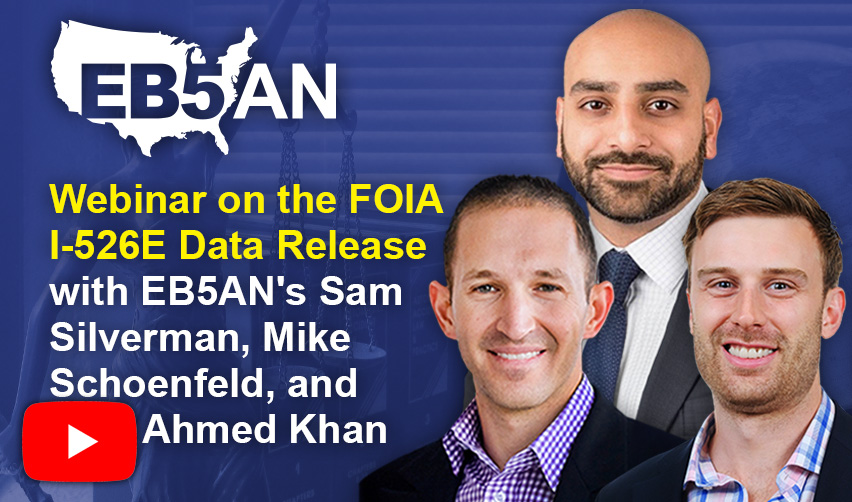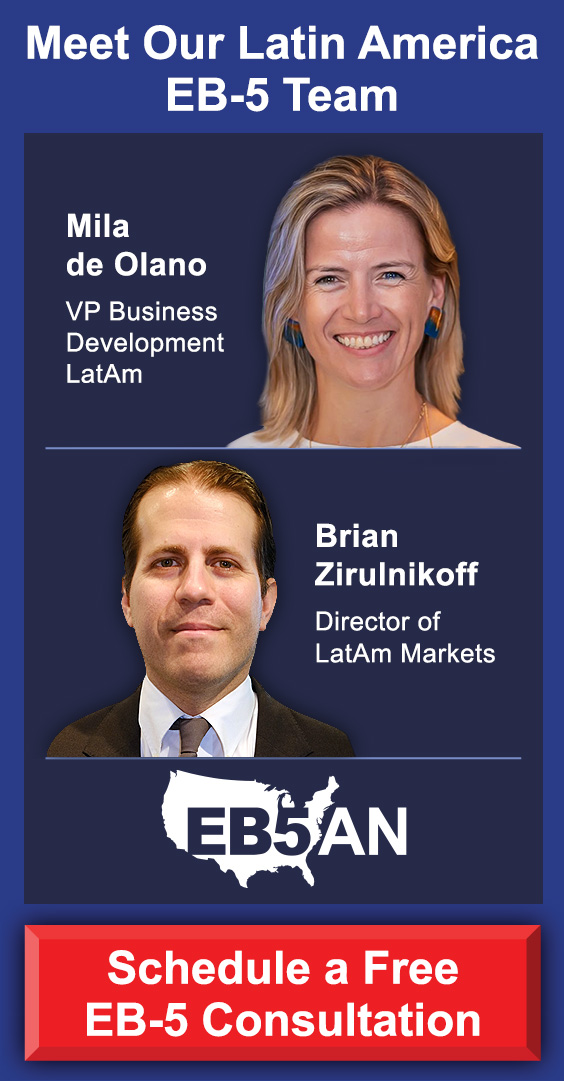On May 8, 2025, EB5AN held a webinar discussing the latest I-526E filing data released by USCIS, now spanning from 2022 to January 31, 2025. These data were released through Freedom of Information Act (FOIA) requests. EB5AN managing partners Sam Silverman and Mike Schoenfeld hosted the webinar and were joined by VP Ahmed Khan.
Essentially, the EB-5 filing statistics confirm EB5AN’s previous projections of a looming urban backlog and a considerably smaller shortfall of supply for the rural project category. China and India continue to produce the highest volume of EB-5 filings worldwide.
The following summary of the EB-5 filing data can help EB-5 investors decide between rural and urban projects, each category offering distinct immigration and financial benefits.
China and India, with a persisting backlog of EB-5 petitions, would likely benefit from the rural category. A rural investment would likely protect Chinese and Indian investors from long-term retrogression.
Once retrogression begins for either the urban or rural categories, investors with pending I-526Es will be ineligible for concurrent filing, work and travel permits, and “locking in” their dependent children’s’ age.
The high volume of EB-5 filings in Q1 2025 indicates that the best time to invest is now—before retrogression begins and while the benefits of the EB-5 Reform and Integrity Act (RIA) remain in place.
Watch Full Webinar
Watch Webinar Highlights
- Breakdown of Rural and Urban EB-5 Filings
- International Distribution of Petitions
- Visa Demand Analysis and Backlog Forecasts
- Recent Trends in Monthly Filings
- Accuracy of EB5AN Forecasts Compared with Actual Data
- Implications of Visa Bulletin Warnings for Chinese and Indian Nationals
- How to Begin the EB-5 Immigration Process Quickly
- Benefits of Investing in Rural EB-5 Projects
Summary: With Backlogs Nearing, the Best Time to File Is Now
Breakdown of Rural and Urban EB-5 Filings
The FOIA data include the number of I-526E petitions submitted through January 2025, including the filings by rural and high-unemployment urban areas. Since the RIA took effect, rural filings have risen steadily from near zero to nearly match urban submissions.
Urban petitions maintain a modest lead—reflecting both established regional centers in cities with high-unemployment areas and investors’ familiarity with this project category. Pre-RIA, rural projects offered no exclusive immigration benefits unavailable to urban projects.
Nevertheless, the rural set-aside category, with 20% of annual EB-5 visas, has attracted substantial interest, narrowing the demand gap with the 10% urban high-unemployment allocation. As more investors see the fast rural I-526E approvals under the RIA, more applicants are choosing rural projects. Still, the volume of urban filings remains larger.
International Distribution of Petitions
Global demand for EB-5 visas seems to be growing beyond the handful of traditionally high-demand countries.
China remains the largest source of I-526E petitions, followed by India—whose filings amount to roughly half of China’s volume.
Collectively, other countries now represent a significant and growing share. Taiwan and South Korea consistently rank among the top non-China/India sources, while Brazil and Vietnam also contribute a steady stream of applications.
Newer countries with a high volume of filings include Canada, Mexico, Turkey, and several European countries, reflecting EB-5’s widening appeal. This geographic diversification intensifies competition for both rural and urban set-asides, as previously dominant markets no longer hold an exclusive claim to priority status. Investors from any of these countries must therefore factor in broader global demand when considering visa availability and potential wait times.
Visa Demand Analysis and Backlog Forecasts
Translating petition counts into visa demand involves multiplying approved I-526E filings by an average of two visas per investor (to cover dependent spouses and children). This number is determined by the latest data on EB-5 dependents attached to each I-526E petition.
Under this assumption:
- Urban (High-Unemployment) Category: Over 10,000 visas required to cover current demand.
- Rural Category: Approximately 8,600 visas required to cover current demand.
These figures exclude petitions already granted conditional U.S. Green Cards––applicants that have reached this stage will no longer deplete the supply of EB-5 visas.
Even though unused visas in the unreserved categories have moved to rural and urban, total visa demand still outpaces supply. Conservative modeling suggests:
- Rural Backlog: Two to three years before all current petitioners can receive their EB-5 visas (that is, U.S. Green Cards).
- Urban Backlog: Five to ten years, given limited annual set-asides and ongoing demand.
These projections assume that the annual visa allocation will remain the same under the current form of the Immigration and Nationality Act (INA) and that EB-5 policy will also remain consistent. Nonetheless, they provide a useful estimate for applicants deciding between rural and urban EB-5 projects.
| Category | Estimated Visas Needed | Annual Visa Supply* | Projected Wait Time |
| Rural TEA (20 % set-aside) | ~8,600 | ~4,000 | 2–3 years |
| Urban TEA (10 % set-aside) | >10,000 | ~2,000 | 5–10+ years |
Recent Trends in Monthly Filings
Month-to-month analysis exposes clear trends in I-526E filings since the RIA was signed into law in March 2022:
- Late 2022 Surge: Regional centers whose projects pre-qualified under RIA’s new rural or urban criteria saw a surge in filings in August–September 2022.
- 2023 Plateau: Following initial documentation delays, monthly receipts stabilized around 200–300 petitions.
- March 2024 Spike: A USCIS fee increase triggered an abrupt tripling of filings as investors rushed to lock in lower costs.
- Q1 2025 Uptick: Speculation about President Trump’s proposed “Gold Card” program and broader policy uncertainty drove monthly filings into the 500–600 range.
Data for the most recent months are still incomplete due to reporting lags of four to six months. However, the trendline clearly indicates accelerating demand, with each policy announcement or fee change causing a surge in filings.
These factors operate in tandem: fee announcements spur immediate action, while policy debates sustain long-term interest.
The immigration benefits under the RIA surely contributed to recent growth in I-526E filings as well. With rural I-526E approvals coming in about 12 months—even as fast as 8.5 months for an EB5AN investor—more applicants acted quickly to secure a faster Green Card.
For EB-5 investors on H-1B and similar visas, the ability to apply concurrently for work and travel permits was an additional incentive.
Accuracy of EB5AN Forecasts Compared with Actual Data
Our early projections anticipated a stabilization of around 400 monthly I-526E filings post-RIA. Actual records for the following eight months averaged approximately 445 petitions per month—within 10% of forecasts. This fairly accurate result shows the usefulness of making projections based on current EB-5 filing data—even if the data are incomplete. Still, as noted above, several factors can make our current data less reliable:
- Exclusion of already-approved applicants with their initial U.S. Green Cards.
- Delays in FOIA data release.
- Unpredictable spikes from fee changes and policy rumors.
For practitioners and prospective applicants, such forecasting accuracy provides a useful planning tool, enabling better anticipation of future filing volumes and resulting visa demand for rural and urban.
Implications of Visa Bulletin Warnings for Chinese and Indian Nationals
The Department of State’s Visa Bulletin issued a preliminary warning in January 2025 that final action dates might be introduced this fiscal year—an early indicator of nearing backlogs for the urban or rural categories. Historically, such warnings precede actual backlogs by one to three months, signaling that visa demand is outpacing supply.
Although a retrogression has not yet materialized, applicants should anticipate its possible arrival before the fiscal year’s end and factor this risk into timing decisions.
Chinese and Indian nationals will face the following consequences when EB-5 visa retrogression begins.
- Concurrent Filing Loss: Upon retrogression, U.S.-based Chinese and Indian petitioners will be unable to file I-485 adjustments alongside I-526E.
- Work and Travel Implications: Without EAD and AP from pending adjustments, investors must rely on existing nonimmigrant status or consular processing abroad—introducing potential gaps in legality or travel freedom.
- Child Age Lock: Chinese and Indian nationals will be unable to “lock in” their children’s ages, preventing them from aging out before receiving their U.S. Green Cards. With a multi-year backlog, their children may no longer qualify as dependents once the I-526E is approved.
By contrast, overseas applicants remain outside the concurrent-filing framework, though they still face extended waits for visa availability once interviews are scheduled at consulates.
How to Begin the EB-5 Immigration Process Quickly
A streamlined, three-step approach maximizes the likelihood of timely filing and visa issuance:
- Retain Immigration Counsel: Early engagement with an immigration attorney guarantees capacity for prompt case preparation. Top-tier firms may reach client limits quickly, so securing representation before peak filing periods is critical.
- Compile Source-of-Funds Documentation: Even straightforward income streams require detailed tracing. Bank statements, tax returns, property sale records, and financing agreements must be assembled and analyzed well in advance to avoid bottlenecks.
- Research EB-5 Projects: While legal and financial documents are in progress, applicants should evaluate regional center offerings against their immigration and investment goals. Site visits, exemplar project approvals (I-956F), and financial performance data are important criteria to consider.
Coordinating these parallel tasks ensures that once funds are wired, applications are ready for immediate submission—ideally before any change in set-aside availability or Visa Bulletin status.
Benefits of Investing in Rural EB-5 Projects
Rural set-aside investments present distinct advantages:
- Accelerated Processing: As adjudicators grow accustomed to rural criteria, I-526E approvals often occur in under 12 months.
- Larger Visa Allocation: The 20% annual rural reserve doubles urban HUA’s share, improving odds of timely visa issuance.
- Shorter Backlog: Even at current demand levels, estimated wait times of two to three years greatly undercut urban TEA delays of five to ten years.
- Reduced Competition: Emerging markets outside China and India benefit most, but even applicants from those countries can leverage rural set-asides for a faster I-526E approval.
For applicants focused on speed and certainty of immigration, rural EB-5 projects represent a compelling path—especially in a post-RIA environment where data transparency and processing efficiencies continue to improve.
Notice the high volumes of I-526E approvals for investors in our rural projects under the RIA. Significantly, 78.8%–the vast majority—have been approved in 8-12 months.
Summary: With Backlogs Nearing, the Best Time to File Is Now
The latest USCIS FOIA data reveal a surge in EB-5 I-526E petitions, with urban filings still outpacing rural. China and India generate the bulk of applications, yet investors from those countries may avoid lengthy visa backlogs by choosing rural projects, which face an estimated 2–3-year wait compared to 5–10 years for urban set-asides.
Rural I-526E filings have grown under the RIA, driven by faster processing. Growing global demand, policy uncertainties and nearing backlogs for both rural and urban highlight that investing now—while RIA benefits are still available—is the best option for a fast Green Card approval.
For personalized guidance on reaching your immigration goals through EB-5, schedule a free consultation with EB5AN.













